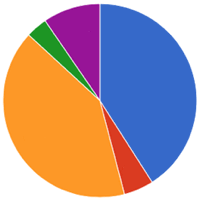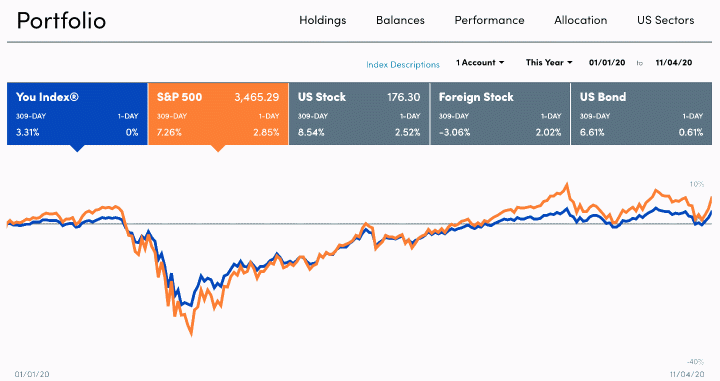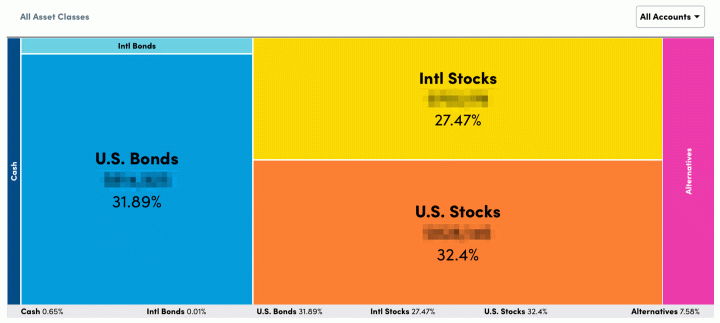
I support the idea of skin in the game, and I wish more “experts” would simply share what they actually own. Here’s my current portfolio update as of November 2020, including all of our 401k/403b/IRAs, taxable brokerage accounts, and savings bonds but excluding our house, cash reserves, and a few side investments. I use these updates to help determine where to invest new cash to rebalance back towards our target asset allocation.
Actual Asset Allocation and Holdings
I use both Personal Capital and a custom Google Spreadsheet to track my investment holdings. The Personal Capital financial tracking app (free, my review) automatically logs into my different accounts, adds up my various balances, tracks my performance, and calculates my overall asset allocation. I still use my manual Google Spreadsheet (free, instructions) because it helps me calculate how much I need in each asset class to rebalance back towards my target asset allocation.
Here are my YTD performance and current asset allocation visually, per the “Allocation” and “Holdings” tabs of my Personal Capital account, respectively:


Stock Holdings
Vanguard Total Stock Market (VTI, VTSAX)
Vanguard Total International Stock Market (VXUS, VTIAX)
Vanguard Small Value (VBR)
Vanguard Emerging Markets (VWO)
Vanguard REIT Index (VNQ, VGSLX)
Bond Holdings
Vanguard Limited-Term Tax-Exempt (VMLTX, VMLUX)
Vanguard Intermediate-Term Tax-Exempt (VWITX, VWIUX)
Vanguard Intermediate-Term Treasury (VFITX, VFIUX)
Vanguard Inflation-Protected Securities (VIPSX, VAIPX)
Fidelity Inflation-Protected Bond Index (FIPDX)
iShares Barclays TIPS Bond (TIP)
Individual TIPS securities
U.S. Savings Bonds (Series I)
Target Asset Allocation. I do not spend a lot of time backtesting various model portfolios, as I don’t think picking through the details of the recent past will necessarily create superior future returns. I mainly make sure that I own asset classes that will provide long-term returns above inflation, distribute income via dividends and interest, and finally offer some historical tendencies to balance each other out. I make a small bet that US Small Value and Emerging Markets will have higher future long-term returns (along with some higher volatility) than the more large and broad indexes, although I could be wrong.
While you could argue for various other asset classes, I believe that it is important to imagine an asset class doing poorly for a long time, with bad news constantly surrounding it, and only hold the ones where you still think you can maintain faith through those fearful times. I simply don’t have strong faith in the long-term results of commodities, gold, or bitcoin.
Instead of staying with my fixed 50/50 target, I am explicitly letting my US/international ratio float with the total world market cap breakdown. I think it’s okay to have a slight home bias (owning more US stocks than the overall world market cap), but I want to avoid having an international bias. I just want to maintain the balance of the total world market cap, which has become roughly 60% US and 40% international. This also means less need for rebalancing.
Stocks Breakdown
- 46% US Total Market
- 7% US Small-Cap Value
- 30% International Total Market
- 7% Emerging Markets
- 10% US Real Estate (REIT)
Bonds Breakdown
- 33% US Treasury Bonds, intermediate (or FDIC-insured CDs)
- 33% High-Quality Municipal Bonds (taxable)
- 33% US Treasury Inflation-Protected Bonds (tax-deferred)
I have settled into a long-term target ratio of 67% stocks and 33% bonds (2:1 ratio) within our investment strategy of buy, hold, and occasionally rebalance. I will use the dividends and interest to rebalance whenever possible in order to avoid taxable gains. I plan to only manually rebalance past that if the stock/bond ratio is still off by more than 5% (i.e. less than 62% stocks, greater than 72% stocks). With a self-managed, simple portfolio of low-cost funds, we minimize management fees, commissions, and taxes.
Holdings commentary. 2020 has been… well… you know. Many times I just have to keep reminding myself that I cannot predict the future, even there appears to be impending doom around the corner. There is no possible way I will know how the stock market will react in a week, a month, or a year. Some businesses will fail and new businesses will start. I just have to trust in capitalism, human ingenuity, human resilience, and our system of laws to allow capital to flow where it can work best over time.
When my equities had dropped significantly and my unrealized gains were low, I thought about moving towards simplicity and selling my positions in the US Small Value (VBR) and Emerging Markets (VWO) classes. However, I realized I actually liked having some extra moving pieces that didn’t move in concert with my relatively large VTI and VXUS positions. I did sell some tax lots of Wisdomtree ETF positions and swapped over to the closest Vanguard ETF equivalents.
I was not disappointed in my decision to hold only the highest-quality bonds and cash equivalents. US Treasuries, TIPS, investment-grade municipal bond funds, FDIC or NCUA-insured certificates of deposit, US savings bonds.
Performance numbers. According to Personal Capital, my portfolio went up about 3% so far in 2020, although the ride has not been nearly as boring as that sounds! I see that during the same period the S&P 500 has gone up +7%, Foreign Developed stocks down -3%, and the US Aggregate bond index was up about +6.6%. These numbers could change quite a bit in a week, so it’s not very useful information.
An alternative benchmark for my portfolio is 50% Vanguard LifeStrategy Growth Fund and 50% Vanguard LifeStrategy Moderate Growth Fund – one is 60/40 and the other is 80/20 so it also works out to 70% stocks and 30% bonds. That benchmark would have a total return of +3.8% for 2020 YTD as of 11/3/2020.
The goal of this portfolio is to create sustainable income that keeps up with inflation to cover our household expenses. I’ll share about more about the income aspect in a separate post.
 The Best Credit Card Bonus Offers – 2025
The Best Credit Card Bonus Offers – 2025 Big List of Free Stocks from Brokerage Apps
Big List of Free Stocks from Brokerage Apps Best Interest Rates on Cash - 2025
Best Interest Rates on Cash - 2025 Free Credit Scores x 3 + Free Credit Monitoring
Free Credit Scores x 3 + Free Credit Monitoring Best No Fee 0% APR Balance Transfer Offers
Best No Fee 0% APR Balance Transfer Offers Little-Known Cellular Data Plans That Can Save Big Money
Little-Known Cellular Data Plans That Can Save Big Money How To Haggle Your Cable or Direct TV Bill
How To Haggle Your Cable or Direct TV Bill Big List of Free Consumer Data Reports (Credit, Rent, Work)
Big List of Free Consumer Data Reports (Credit, Rent, Work)
Thank you, Jonathan. Which ETFs have you chosen for your bond holdings? How come you’re not looking into mutual funds for each slice? Also, you are missing out on the tech chase, no invididual names?
I included the mutual fund tickers of the bond funds I own in the post.
I own the tech companies in whatever proportion of the US total market cap they are. AAPL is 5%, MSFT is 5%, Amazon is 4%, Google 3%. I will always own the winners 🙂
Get some crypto or you may regret it in the future. Here is Fidelity’s bitcoin investment thesis, in case you are interested: https://www.fidelitydigitalassets.com/bin-public/060_www_fidelity_com/documents/FDAS/bitcoin-alternative-investment.pdf
Thanks for the read. I don’t think calculating correlations for BTC vs. equities for such a short time frame is all that helpful, but I do agree that some people may own a little bit for diversification purposes. I own a *really* little bit, less than 1 BTC, but honestly I don’t understand it enough to buy more.
I think I comment on your portfolio ever year. Just my opinion, but I think you should move REIT and small cap money to S&P. I enjoy your blog
Thanks for your comment. It’s a reasonable suggestion.